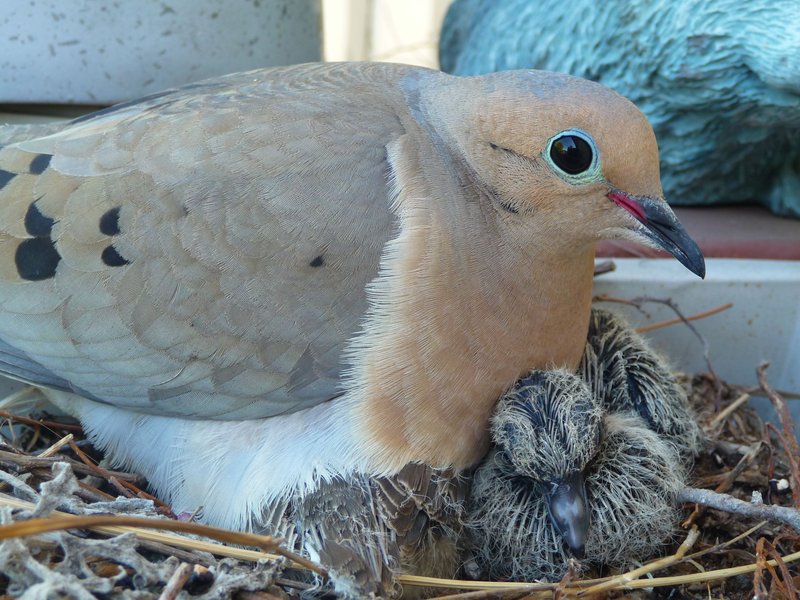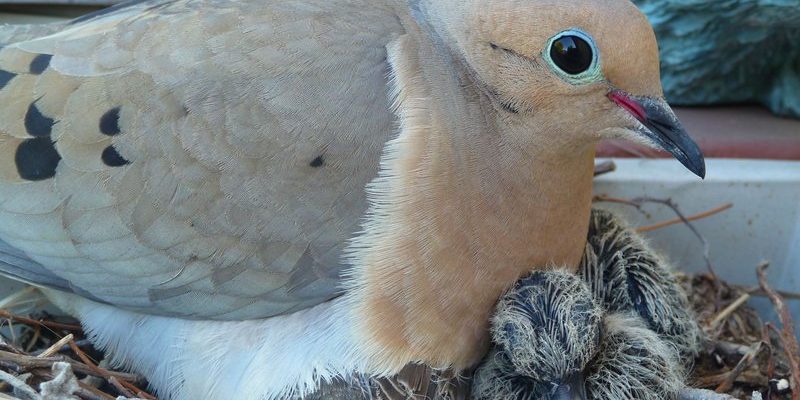
Mourning doves are not only common in North America, but they also play a vital role in our ecosystem. They’re a part of nature’s soundtrack and symbolize peace and comfort with their soothing calls. If you’ve ever been curious about how mourning doves build their homes, what their life stages look like, or how they care for their babies, pull up a chair. Let’s dive into the world of these charming birds and uncover what makes their nesting habits and lifecycle so special.
Where Do Mourning Doves Nest?
Mourning doves have an interesting approach to finding a place to call home. Unlike some species that build elaborate nests, these birds prefer a more straightforward setup. You might find them nesting in a variety of locations, from the branches of trees to the ledges of buildings. They often choose spots that provide some level of cover, like shrubs or vines, to keep their eggs safe from predators.
In urban areas, it’s not uncommon to see them nesting in places you might least expect. Some have been known to build their nests on window sills or in high, sheltered spots. Here’s the thing: they’re not picky! They can adapt to different environments, which helps them thrive in both rural and suburban areas.
When it comes to the actual construction of the nest, mourning doves use twigs, grass, and bits of leaves. They might not be the most skilled architects, but their simple, loosely-made nests serve their purpose well. It’s a bit like throwing together a quick meal when you’re hungry—quick and functional!
Mourning Dove Eggs: The Starting Point
Once a pair of mourning doves has settled on a nesting site, the female lays usually two eggs. These eggs are a pale, creamy color and are often speckled with darker hues, which makes them blend in nicely with the nest. You might be wondering why they lay two eggs. Well, having two offers a backup plan; if something happens to one, their chances of raising at least one healthy chick increase.
The female is usually the one to incubate the eggs for about two weeks. During this period, the male stays nearby, keeping watch and helping out with the tasks that need to be done around their home. Honestly, it’s quite the team effort! They take turns sitting on the eggs to ensure they stay warm and safe. This nurturing behavior is crucial, as it showcases their strong bond and commitment to their future offspring.
The Hatching Process
After about two weeks of diligent care, the moment arrives—the eggs begin to hatch! The chicks, called squabs, are born blind and featherless, which means they rely completely on their parents at this stage. Watching these tiny, helpless creatures emerge from their eggs is like witnessing a miracle. It’s a bit chaotic, almost like a tiny family reunion!
Once the squabs are out, both parents continue to play an active role in their upbringing. They feed the chicks a special substance known as pigeon milk. Yes, you read that right—pigeon milk isn’t actually milk at all but a nutrient-rich secretion produced in their crop. This incredible food source is packed with proteins, fats, and other essential nutrients, making it perfect for growing birds.
In just about two weeks, the squabs start to grow feathers and become more independent. They still depend heavily on their parents, but soon enough, they’ll be ready to take flight. The bond between parent doves and their young during this period is genuinely touching.
How Long Do Mourning Doves Stay with Their Parents?
Once they’ve fledged, or taken their first flight, you might think that the squabs are off on their own. But here’s the thing—mourning doves aren’t like some other birds that kick their young out immediately. Instead, they tend to stay around their parents for a little while longer, learning the ropes of survival.
Typically, young doves will remain with their parents for about 2 to 3 weeks after leaving the nest. During this time, they follow their parents around and learn how to find food, build their strength, and develop their flying skills. It’s a crucial stage in their development, as they practice their skills and gain confidence before venturing out independently.
Throughout this phase, the parents still provide guidance and support. It’s like a supportive family working together to ensure everyone is ready to stand on their own two feet—well, wings in this case!
Mourning Dove Lifespan and Reproductive Cycle
Mourning doves have a relatively short lifespan compared to some other bird species. In the wild, they typically live around 1 to 3 years, although some have been known to reach up to 10 years under ideal conditions. Factors like predators, disease, and habitat loss can all influence their lifespan.
In terms of reproduction, mourning doves are quite prolific. They can breed up to 3 to 6 times a year, depending on food availability and environmental conditions. This frequent breeding cycle becomes particularly impressive when you consider that they can raise two squabs at a time. If you calculate that out, one pair of mourning doves can produce numerous offspring in just one year!
This prolific breeding is vital for their population maintenance, especially considering the challenges they face in the wild. It’s a natural cycle that keeps the mourning dove populations stable, so they can continue to grace our backyards with their gentle presence.
Understanding Mourning Dove Behavior
Mourning doves are fascinating creatures with distinct behaviors that make them relatable to many. You might notice how they coo softly, often in pairs. Their calming sounds can create a peaceful atmosphere, and honestly, there’s something comforting about it. They also engage in social behaviors, often seen foraging together or preening each other’s feathers.
These birds are generally non-aggressive and skittish. If startled, they often take off with a quick, fluttering flight, which is a reminder of their fragile nature. You might see them instinctively make sudden movements to evade threats, showcasing how instinctual behavior is essential for survival.
Interestingly, mourning doves are also known for their strong pair bonds. These affectionate displays can be seen during courtship, where mates will preen each other and perform gentle cooing calls. Their deep connection reflects a strong partnership vital for nurturing their young.
Protecting Mourning Doves in Your Backyard
If you’re lucky enough to have mourning doves in your area, you might want to create a welcoming environment for them. Planting native shrubs and trees can provide perfect nesting spots. Additionally, providing fresh water sources, like bird baths, can attract them to your yard.
You might also consider avoiding the use of pesticides or harmful chemicals. These substances can harm not only the doves but also the insects and seeds they rely on for food. Here’s the thing: creating a bird-friendly space can be beneficial not just for mourning doves but for many other species too, enhancing your local ecosystem.
Keeping your garden a safe haven allows mourning doves to thrive and contribute to the beauty of nature around you. Every action you take can help foster a healthy environment for these gentle birds.
In conclusion, mourning doves are not just another bird flitting around; they are a remarkable part of our ecosystem. Understanding their nesting habits and lifecycle gives us a deeper appreciation for their beauty and resilience. So next time you hear their soothing cooing, take a moment to appreciate the little lives soaring around you, and remember the incredible journey they’ve taken to get there.

